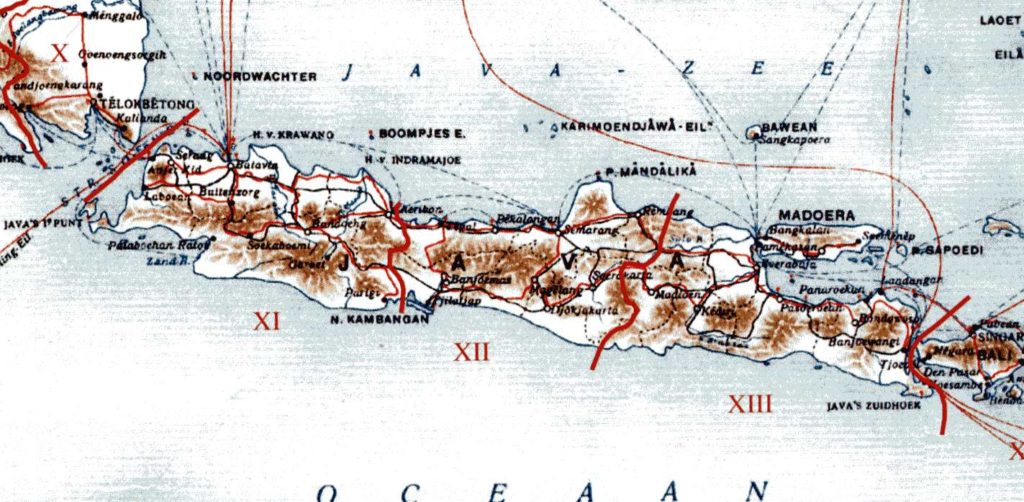Java
Java Civilian Japanese Prison Camps

The largest concentration of Civilian Prison camps was established on Java by the Japanese Imperial army. The short term purpose of this huge incarceration policy was to remove all western influence from Javanese society. The long-term objective has never been declared or revealed, though can be inferred from the pattern of prison camp evolution. Below is presented a broad overview of the evolution for the period between Dutch capitulation ( 8 March 1942) and Japanese capitulation ( 15 August 1945) . Both the start as well as the ending of this incarceration phase was gradual. The start was complicated by a number of factors
- Uncertainty as to how to define “Western Influence”. Was this restricted to ethnic Europeans , or to those who had adopted European outlook on life? Where did Middle eastern ethnic groups , not to forget the Chinese population fit in ?
- The scattered nature of Western penetration on Java: cities , villages , mission posts and plantations
- The need for Japan to honour some international obligations towards the Third Reich.
The ending of incarceration was equally piecemeal due to the bizarre ending of the Pacific War, and the chaos that ensued. Some prisoners sought freedom shortly after August 15, 1945 when Japanese guards ceased imposing their will. Other prison camps remained in place long after that date to protect the civilian POWs from a new menace, the Indonesian uprising, or Bersiap. The following table should be seen in this light:
| Java Civilian Prison Camps | ||
| Region | Number of Camps | |
| Dec-42 | Aug-45 | |
| West Java | 54 | 18 |
| Midden java | 36 | 11 |
| East Java | 20 | 1 |
| Total | 110 | 30 |
What this table illustrates is the huge logistical effort taken by the Japanese imperial army to reduce the burden placed on the army of occupation to achieve its political end. This ongoing effort was pursued until the very last day of the war.
The source of this and following data is to be found in the website:
www. Japanseburgerkampen.nl
Japanese Civilian Prison Camp Population on 15 August 1945
| Civilian Prison Camps on Java August 1945 | ||||
| Region | District | Camp | Men and boys | Women and Children |
| West Java | Batavia | ADEK | 2000 | |
| Glodok | 595 | |||
| Kampong Makassar | 3500 | |||
| Kramat | 2000 | |||
| Mater Dolorosa | 1000 | |||
| Sint Vicentius | 1200 | |||
| Struiswijk | 1400 | |||
| Tjideng | 11000 | |||
| Buitenzorg | Kedoeng Halang | 93 | ||
| Kelpanoegal | 145 | |||
| Soekaboemi | Rosali (hosp) | 150 | ||
| 4de en 9de bataljon | 8000 | |||
| Baros 5 | 2400 | |||
| Baros 6 | 1700 | |||
| Goenoeng halos | 360 | |||
| Pasir Benteng | 170 | |||
| Bandoeng | 15de Bataljhon | 8000 | ||
| Tjihapit | 31 | |||
| Subtotal | 23570 | 20143 | ||
| Midden java | Bangkong | 1300 | ||
| Halmaheira | 3300 | |||
| Lampersari | 7600 | |||
| Ambarawa 6 | 4000 | |||
| Ambarawa 7 | 2500 | |||
| Ambarawa 9 | 700 | |||
| Banjoebiroe 10 | 5300 | |||
| Banjoebiroe 11 | 2300 | |||
| Banjoebiroe 12 | 1200 | |||
| Rawaseneng | 100 | |||
| Subtotal | 3900 | 24400 | ||
| East Java | Batoe | Sanatorium | 50 | |
| Grand total | 27470 | 44593 | ||
The above table shows how that population of undesirables civilians was split into two groups: women and children in one set of camps and men and boys in another set of camps. Boys over the age of ten were no longer deemed “children ” under Japanese army regulations. The population of the men’s camps is ambiguous because the available data does not make clear the difference between the western concept of “Man” and “Boy”.
The table also reflects the fact that Eastern Java and its prominent cities ( Surabaia- a major naval base) for instance) , was completely cleared of “westernised ” undesirables.
Suriving Lists of Names of Civilian Internees
| Java: Surviving names lists | |||
| Region | Camp | Men and boys | Women and children |
| West Java | ADEK | 2221 | |
| Kramat | 1217 | ||
| Struiswijk | 75 | ||
| Tjideng | 4911 | ||
| 4de en 9de bataljon | 9418 | ||
| Baros 5 | 2824 | ||
| Baros 6 | 2128 | ||
| Goenoeng halos | 341 | ||
| Pasir Benteng | 151 | ||
| Subtotal West Java | 14862 | 8424 | |
| Midden java | Bangkong | 1493 | |
| Lampersari | 4121 | ||
| Ambarawa 6 | 3938 | ||
| Ambarawa 7 | 325 | ||
| Banjoebiroe 10 | 1632 | ||
| Subtotal Mid Java | 1493 | 10016 | |
| Grand total | 16355 | 18440 | |
The above table summarises the prison camps for which a list of names survived the ending of the war .
Leave a Reply